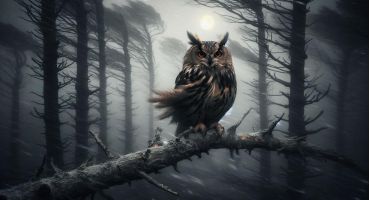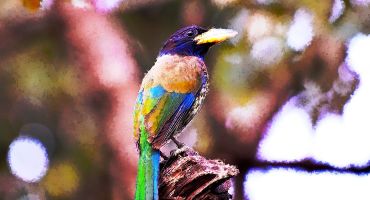Once upon a time, there were cordial and close relations between the Hangmangs and Sitmangs. Hangmangs are living beings, and Sitmangs are the dead human spirits. The relationship between these two entities was cordial, and they could see and feel each other. They lived together and also had marital relations with each other. There was no fear or animosity between these two entities. The only difference between these two entities was that any object that was large in the eyes of Sitmang (the dead) would look small in the eyes of Hangmang (the living) and vice versa.
In a village, there was a married couple. The husband was a Hangmang, and the wife was a Sitmang. They lived a quiet and happy life. One day Hangmang decided to visit his inlaws who lived in the next village. When he reached their house, his wife’s relatives were getting ready for a hunt in the forest. Seeing that their son-in-law had arrived, they rejoiced and immediately invited him to accompany them on their hunting expedition. When they reached the entrance to the forest, the relatives left the Hangmang son-in-law there and went deep into the woods in search of game. As the Hangmang son-in-law waited alone at the entrance, a tiny Bagchala (Grey Wagtail Bird) flew past him and entered a bush.
A few moments later, the hunters returned.
They asked him, ‘Have you seen any Yangbak (Wild Boar) come this way?’
For the Hangmang, it looked like a small bird, and so he said,
‘No, but I saw a small Bagchala bird enter that bush.’
‘Oh, that’s what we were searching for. Where did it go?’ asked the hunters.
‘I think I saw it enter this bush,’ said Hangmang, and he beat the bush with a stick. The stick accidentally hit the bird, and it came out of the bush and dropped dead at his feet.
‘Oh, this is it,’ cried the happy hunters. For them, it was a large bird, and with great difficulty, they picked it up and went back to the village.
Back home, they cut up the bird into large pieces. Then they packed a big chunk of the bird’s legs and gave it to Hangmang as a gift for their daughter. He took it back to his wife and opened the packed meat, and roasted it on the fire. As he was giving the bird meat to his wife, it slipped out of his hand and landed upon his wife’s legs. But for the Sitmang wife, it was much larger, and its weight crushed her legs. Soon the news of this incident spread across the village, and it reached the Sitmang wife’s relatives.
Both the Sitmangs and the Hangmangs decided that they could not live together as it would cause practical problems in their world. The Hangmangs declared, “Our rituals, traditions are different which have caused problems between our societies. We must have a pact that we shall never cross each other’s paths and live in our respective worlds. Let Hangmangs stay with their kind and let Sitmangs stay with theirs. We will not talk to each other, nor shall we meet. Let our worlds become demarcated by the Bahibak (Castanopsis). Let the boundaries created by the Bahibak be always respected.”
Everyone agreed. So the realms of the Hangmangs and the Sitmangs were divided. Bahibak became a symbol of this boundary between the two worlds. Since the Kirati Khambu people are nature worshippers, they worship seasonal flora and fauna, hills and valleys in the form of divine spirits and their ancestors. For most rituals from birth till death, they make use of Bahibak (Castanopsis).





